|
|
News items from 2014 on the 'Pocklington and District Local History Group' website.
Back to Latest News |
|
| A Wartime Evacuee |
| 20th Nov. 2014 |
|
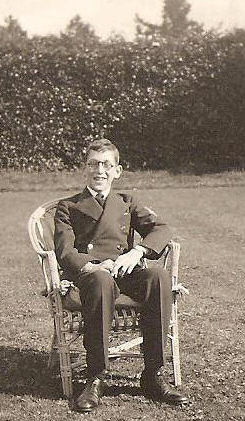 Memories of the Second World War at Pocklington were revived when Pocklington and District Local History Group met in their November meeting. Jim and Margaret Ainscough gave a presentation about a young evacuee, Michael Ford, who was a pupil at Hull’s Hymers College which shared Pocklington School’s facilities until the end of 1942. He maintained detailed and warm recollections and friendships of his wartime experiences right up to the time of his death in 2013, and Michael passed on everything he remembered about Pocklington to Jim and Margaret Ainscough when they were writing the book 'Pocklington at War'. For three months he was billeted in the servants’ quarters at Burnby Hall but he was bullied by the older boys. So he was sent to live with the local blacksmith. Joe Scales, his wife Elsie and their daughters Maud and Brenda welcomed Michael, as he said, as “an honorary member of the family”. They lived on Summerson Terrace, in one of the town’s first council houses. There was no electricity, only three rooms had gas lighting and it had an outside toilet. But Michael described it as “a little piece of heaven for what it lacked in material attributes it more than compensated in cleanliness, comfort and family warmth”. Michael and the family remained lifelong friends. Michael’s vivid recollections of the war included looking out of his bedroom window one moonlit night to see a German fighter-bomber flying low over Victoria Road. He wrote, “How it cleared the church tower I don’t know”! He also recalled additional prep sessions in the old Wesleyan chapel schoolrooms on Chapmangate, of other evacuee children from a deprived part of Sunderland who were also sent to Pocklington, and of being sent out to help the war effort by pulling carrots in a field off Percy Road; and his story provided a fascinating insight and tribute for Thursday night's talk. Photo shows Michael Ford in the grounds of Burnby Hall in the autumn of 1939. |
| |
| The Fallen Heroes Exhibition |
| 31st Oct - 7th Nov 2014 |
|
| Pocklington's Fallen Heroes exhibition to commemorate the town's World War One heritage and those who gave their lives in the conflict got underway with a memorable opening ceremony on Friday 31st Oct. 2014, at Pocklington Arts Centre. An audience of over 150, which included several descendants of Pocklington's fallen heroes, were welcomed by the town mayor, Councillor Paul West, who then received a regimental plaque from Lieutenant Colonel Graham Whitmore in memory of all the Pocklington men from his regiment who died fighting in the war. Gareth Hughes, head of history at Pocklington School, takes annual parties of school pupils to Flanders; and he is the author of a recently published guidebook to its battlefields and cemeteries. He set the context of the war, spoke about how his grandfather's experiences in 1914-18 first sparked his interest, and how he helps the young people he leads on the trips to try and understand the conflict. But the undoubted stars of the evening were two of Pocklington's World War One veterans who are no longer with us. Pocklington & District History Group archivist, Andrew Sefton, played an audio visual presentation that included the reminiscences of local men Billy Harrison and George Barker, who were interviewed for an aural history project in York circa 1980. Billy Harrison was born in Nunburnholme, started out as a gardener at Warter Priory, and became a well known local character and musician. He signed up at Pocklington in February 1917 and within weeks was in the front line in France. His interview was played to the captivated audience as he described going over the top with his platoon of 120 men, and how only ten survived unscathed. The fitting finale was provided by the singing of George Barker. A film was played of a memorial parade showing many of Pocklington's World War One veterans marching through the town in 1932, and Barker's moving renditions of the songs he sang in the trenches, such as 'Long Way to Tipperary' and 'Pack Up Your Troubles', were added as a soundtrack. The videos and sound tracks were running on a continuous loop in the exhibition. The exhibition closed on the 7th Nov. 2014. |
|
|
|
The Mayor of Pocklington Councillor Paul West welcomes everyone to the Fallen Heroes exhibition opening at the Arts Centre
|
Pictured before the Fallen Heroes exhibition are (l to r): Councillor Martin Ratcliffe, Deputy Mayor of Pocklington; Gareth Hughes, WWI author and keynote speaker; Lieutenant Colonel Graham Whitmore, Army Liaison Officer from 15 (North East) Brigade in York; Rowan Blake-James, Deputy Lieutenant of the East Riding; Andrew Sefton, Pocklington & District Local History Group archivist; and Councillor Paul West, Mayor of Pocklington. |
|
|
Lieutenant Colonel Graham Whitmore, Army Liaison Officer from 15 (North East) Brigade in York presents a plaque to Paul West, Mayor of Pocklington |
A profile of every one of the 53 fallen heroes was on display |
|
|
Phil Gilbank and Andrew Sefton who put together the exhibition |
Martin Cooper who did the original research next to the lighted candle and 53 poppies at the exhibition - one for each of the 53 Pocklington men who died in WWI. |
| |
All photographs above by kind courtesy of Roger Pattison |
| |
| The Parisi |
| 20th October 2014 |
|
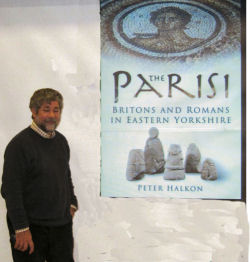 Dr. Peter Halkon is an acknowledged leading authority on the Parisi tribe in East Yorkshire. His archaeology excavations of the Hasholme boat, led to a better understanding of a large inlet of water from the Humber named the River Foulness. The valley of the river was a centre of early Iron Foundries which cast the weapons and wheel rims for the chariots of the Parisi peoples of the wolds. These spear and chariot burials are unique to East Yorkshire and the Paris basin, with 'Par' being an ancient word for a spear. The Romans feared these warrior peoples and built a line of defensive forts surrounding the wolds from near Scarborough, round to Malton, Buttercrambe and Hayton (which Peter excavated). A full attendance in the Arts centre enjoyed Peter's accomplished delivery and stunning visuals. A memorable evening enjoyed by all. Peter's book 'The Parisi: Britains and Romans in Eastern Yorkshire' is available from all good booksellers. Dr. Peter Halkon is an acknowledged leading authority on the Parisi tribe in East Yorkshire. His archaeology excavations of the Hasholme boat, led to a better understanding of a large inlet of water from the Humber named the River Foulness. The valley of the river was a centre of early Iron Foundries which cast the weapons and wheel rims for the chariots of the Parisi peoples of the wolds. These spear and chariot burials are unique to East Yorkshire and the Paris basin, with 'Par' being an ancient word for a spear. The Romans feared these warrior peoples and built a line of defensive forts surrounding the wolds from near Scarborough, round to Malton, Buttercrambe and Hayton (which Peter excavated). A full attendance in the Arts centre enjoyed Peter's accomplished delivery and stunning visuals. A memorable evening enjoyed by all. Peter's book 'The Parisi: Britains and Romans in Eastern Yorkshire' is available from all good booksellers.
|
| |
| Richard III and the Middleham Jewel |
| 25th Sep 2014 |
|
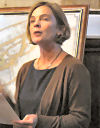  Dr. Kate Giles examined the jewel which is held on display by the Yorkshire Museum in York, and related the messages conveyed on the jewel with its possible links to Richard III of York. The story of the finding of the Middleham jewel had much intrigue, suspense, crime and mystery. The final purchase of the jewel was made by the Yorkshire Museum for £2.5 million. Kate gave a gripping presentation with one attendee saying it was the best one and half hours entertainment he had experienced for a long time. Dr. Kate Giles examined the jewel which is held on display by the Yorkshire Museum in York, and related the messages conveyed on the jewel with its possible links to Richard III of York. The story of the finding of the Middleham jewel had much intrigue, suspense, crime and mystery. The final purchase of the jewel was made by the Yorkshire Museum for £2.5 million. Kate gave a gripping presentation with one attendee saying it was the best one and half hours entertainment he had experienced for a long time.
|
| |
| Seaton Ross Walk |
| 3rd July 2014 |
|
A very interesting and well researched walk in Seaton Ross, kindly both led and researched by Jane Henley, with many glimpses into the past. Although most of the houses have been either re-built or regenerated in the 19th c., many of them have fascinating stories to tell. Quite a lot of the history seems to be dominated by Wm Watson, there have been other influential residents, including the Cook family who among other things ran a mustard mill at the North end of the village. The Church is interesting, brick-built in late 18c., on the site of a former Norman place of worship. There are also 2 Methodist Chapels, both close to the Church. The walk went past an unusual 'Village Garden', with a variety of flowers, and some very good mature apple trees. The visit ended with a kind invitation from John Rowbottom to see the old mills. One was a former 5 sail windmill; now sadly a mere shell. Next to the windmill is a steam driven mill, formerly with a beam engine, now fitted with a fine example of a 19c traction engine. Although the engine is a runner, it cannot drive the mill. We all repaired back to the village hall, where cake and tea were consumed with enjoyment, whils we looked at many images of the past in the form of collections of photographs, some on the walls, and some from Andrew Sefton's Local History archive.
(Report by
Peter Green.) |
|
|
|
Inside St. Edmunds Church
|
William Watson's sundial above the door |
|
|
Jane Henley explaining the history |
Outside dial cottage |
|
|
The mill workings |
A surviving Windmill |
| |
| Pocklington in 1260 |
| 15th May 2014 |
|
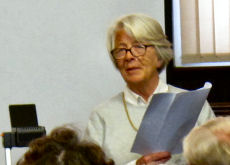
Barbara English has carefully transcribed an Extent for Pocklington from 1260 and presented to the group copies for us to consider and discuss. It therefore developed into an interesting workshop and debate about the occupations and society status in feudal Pocklington. It was even found that a couple of surnames such as Goddard and Colley survive in the town today. Her transcription can be viewed here. |
| |
| Flying Man celebrations 2014 |
| 10th/11th May 2014 |
|
|
|
60 Flying Men, Women and Children
|
Phil Gilbank, the 2014 Jester, accepting the challenge of Thomas Pelling's memory |
|
|
Pocklington Super Heroes |
The 'Flying Man' Cafe |
|
|
The History Group display |
Bernard Ross's impressive Airfield Model |
| |
|
| The Pocklington Church Plate |
| 25th April 2014 |
|
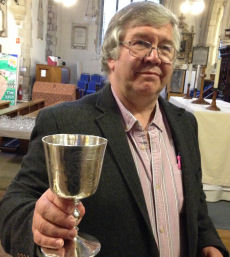 Not a History Group event but notable historical news. Phil Gilbank showed and talked about Pocklington's church plate treasures. All Saints has a marvellous collection of church plate of the 17th,18th and 19th centuries that includes some outstanding examples of the work of leading 17th century silversmiths. Many pieces of the church plate have a fascinating story to tell, and Phil related some of these stories, including the silver chalice that has a connection to Bing Crosby, and a brass alms dish from the 1880s with links to Kate, Duchess of Cambridge. He is seen holding the special chalice that Phil discovered was made by a renound York Goldsmith John Plummer who actually was from Pocklington. The Chalice has the arms of the Belt family and dates from the 17th century. Not a History Group event but notable historical news. Phil Gilbank showed and talked about Pocklington's church plate treasures. All Saints has a marvellous collection of church plate of the 17th,18th and 19th centuries that includes some outstanding examples of the work of leading 17th century silversmiths. Many pieces of the church plate have a fascinating story to tell, and Phil related some of these stories, including the silver chalice that has a connection to Bing Crosby, and a brass alms dish from the 1880s with links to Kate, Duchess of Cambridge. He is seen holding the special chalice that Phil discovered was made by a renound York Goldsmith John Plummer who actually was from Pocklington. The Chalice has the arms of the Belt family and dates from the 17th century.
|
| |
| The AGM and Town Crier |
| 24th Apr 2014 |
|
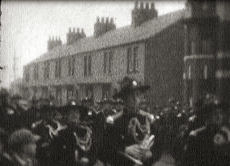
Jo Green was re-elected for the chair and outlined the objectives of the group and concluded on another successful year. Treasurer Peter Green also showed a healthy situation for the finances of the group.
2014/15 Re-Elected Committee: Chair & Secretary– Jo Green, Treasurer – Peter Green, Archivist/Webmaster – Andrew Sefton, Committee – Phil Gilbank, Dennis Moor, Paul Jennings, David Rumbelow, Chris Bond, Jane Henley (representing the villages) and David West. Roger Bellingham is Honorary President. The AGM was followed by an inspirational talk by Geoff Sheasby (Pocklington Town Crier) on the history of Pocklington Criers and a photographic review of the year including the "World Premiere" of the oldest film of Pocklington in existence. It was recently discovered and has been transferred to digital format. It was filmed on 20th November, 1932, and shows soldiers and the Pocklington Cadets marching in Barmby Road and Railway Street, on a WW1 Memorial Parade. |
| |
| The Rise and Fall of the Dolmans |
| 20th Mar 2014 |
|
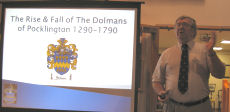
Pocklington school is 500 years old this year and it was appropriate that the story of the school founders, the Dolman family, be told in the school library. An old boy Phil Gilbank gave a comprehensive review of the rise in fortune of the Dolman family and their downfall caused by their devotion to the catholic faith, and usually backing the losing side in any conflict. Chris Rock created some super illustrations to accompany the event. |
| |
| Community Archaeology |
| 20th Feb 2014 |
|
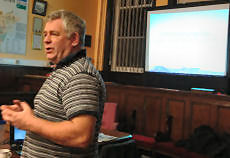 Jon Kenny is community achaeologist for the city of York. His role is to involve local communities into taking an active role in the participation of researching and excavating local sites of interest. He has a number of local groups participating and gave examples at North Duffield, Bilborough, Stockton, Strensall, Broughton, Hessay, Hornington and Copmanthorpe. The possibilities for Pocklington were discussed and there seemed to be interest expressed. If you would like to get involved please contact the committee members. Link to York Community Archaeolgy Website. Jon Kenny is community achaeologist for the city of York. His role is to involve local communities into taking an active role in the participation of researching and excavating local sites of interest. He has a number of local groups participating and gave examples at North Duffield, Bilborough, Stockton, Strensall, Broughton, Hessay, Hornington and Copmanthorpe. The possibilities for Pocklington were discussed and there seemed to be interest expressed. If you would like to get involved please contact the committee members. Link to York Community Archaeolgy Website.
|
| |
| Member Short Talks |
| 23rd Jan 2014 |
|
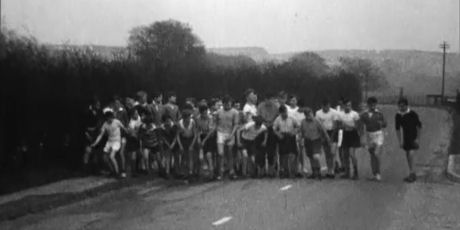
Short Talks open evening (Above is a still from the cine film taken in 1960)
1. Peter Green and Mike Skelton - "Rocks of Ages"
Considering the East Riding has mostly chalk and soft limestone, what did the locals use to build the churches? Mike and Peter gave us a talk on where the stone was sourced from, how it was transported and how it was used and how the masons applied their own masons mark.
2. David Rumbelow - "A formidable Tudor lady"
David talked about Joan Ackworth, who was lady of Pocklington Manor, and colourfully presented the life and times of the tudor court of Henry VIII in which she lived and participated.
3. Phil Gilbank- "Harry Wood MM, VC – the tragic hero".
Phil stepped in to give the talk about a most fascinating man Harry Wood from Newton on Derwent, whose life story almost sounds a work of fiction. He won the Military Medal for heroism in the first world war, only to return later to win the Victoria Cross for bravery, and then by a wicked twist of fate to die of shock in 1924 when he saw his wife run down in a car accident.
4. An Old Film of Pocklington and Woldgate School around 1960 by Robert Sefton.
Andrew showed his brothers 9.5mm cine film of Bishop Wilton village life, Pocklington and Woldgate school, recently scanned by the Yorkshire Film Archive.
|
| |
| Past News Stories |
| |
| News Stories from 2016 |
| |
| News Stories from 2015 |
| |
| News Stories from 2014 |
| |
| News Stories from 2013 |
| |
| News Stories from 2012 |
| |
| News Stories from 2011 |
| |
| News Stories from 2010 |
| |
| News Stories from 2009 |
| |
| News Stories from 2008 |
| |
| News Stories from 2007 |
| |
|
|
|
|

